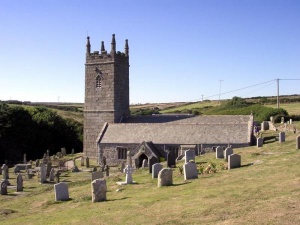Sant Levan
Un article de GrandTerrier.
1 Fiche signalétique
|
2 Almanach
| ||||||||||||||||||||
3 Sources
|
4 Iconographie | ||||||||||||||||||||
5 Monographies
Groupes Yahoo / Celt-Saints :
St. Levan (Levin)
6th century. The Irish Saint Levan (possibly a shortened form of Silvanus) migrated to Cornwall, where he gave his name to a parish (Benedictines).
The Baptistry and Chapel of St Levan.
The Holy Well of St Levan and the Baptistery lie beside the footpath leading to Porth Chapel Beach. They are connected to the small Chapel on the cliff edge further down by a flight of about fifty stone steps. The existence of these steps had been known for many years, but they were uncovered as a result of excavations in 1931.
The St Levan Stone.
On the south side of the church near the porch is the rock known as St Levan's Stone. It is broken in two, and it was said that St Levan sat upon this rock when tired from fishing, Wishing to leave a memento of himself in connection with his rude but favourite seat, one day he gave it a blow with his staff and cracked it through. He prayed over the rock and uttered the following prophecy.
When with panniers astride,
A Pack Horse can ride,
Through St Levan's Stone,
The world will be done.
In pre-Christian times the stone was evidently venerated as a Holy Rock, since it has never been removed, nor has any attempt been made to destroy it.
The Crosses
There were at one time at least six granite crosses of a Celtic pattern which marked the paths radiating the Church to outlying hamlets and farms. The finest specimen, which was 6' 11" high, stands in the churchyard to the right of the path leading to the south porch. It may well be in its original position, as the churchyard is the site of an ancient enclosure. A second cross is to be found in the churchyard wall, beside the entrance stile at the north east corner.
